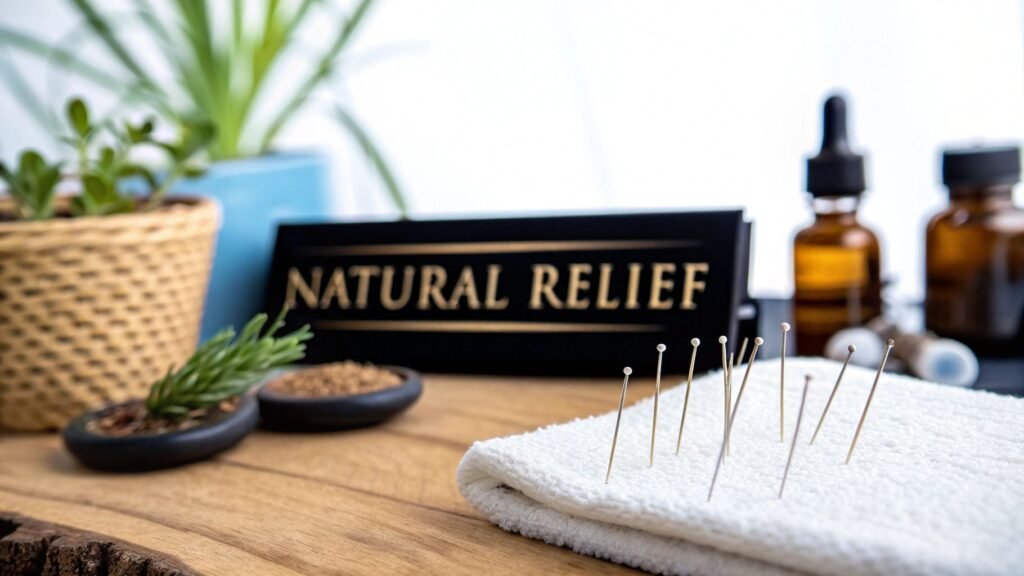When you're staring at another pill bottle, it’s natural to ask, "Isn't there a better way?" The good news is, there is. Non-drug pain management isn't just a hopeful idea; it's a powerful approach that uses evidence-based therapies like acupuncture and physical therapy to get to the root of your discomfort, all without relying on medication.
This entire philosophy is about helping your body remember how to heal and function on its own.
Moving Beyond Medication for Pain Relief
For many people, the search for pain relief feels like a revolving door of prescriptions. Each new medication comes with its own list of side effects and limitations, and it can leave you feeling trapped in a cycle of just masking symptoms instead of actually solving the problem.
But there’s a different path—one that’s grounded in restoring the body’s natural ability to function and heal.
Non-drug pain management isn’t some fringe alternative. It's a well-established field in healthcare that offers real, sustainable solutions for both short-term injuries and long-term chronic conditions. It's about empowering you to take an active role in your own healing, moving past a passive reliance on pills.
Shifting the Focus from Symptoms to Solutions
Think of it this way: medication often acts like a smoke detector with the batteries pulled out. It silences the alarm, but the fire is still burning. Non-drug therapies, on the other hand, are about finding the source of the fire and putting it out for good.
This fundamental shift in thinking is gaining serious momentum. As more people search for safer, more effective long-term options, the healthcare world is finally starting to catch up. You can see this change reflected in market trends, which show a clear demand for non-pharmaceutical treatments.
In fact, the global market for non-opioid pain treatments is currently valued at around $45.3 billion and is expected to keep growing. This isn't just a niche movement; it's a worldwide shift in how we think about and treat pain.
This approach is about building a toolkit for your body. Each therapy adds another tool you can use to manage discomfort, improve function, and enhance your overall quality of life, giving you more control over your health.
Exploring a Diverse Toolkit of Therapies
The world of non-drug pain management is incredibly diverse, offering a whole spectrum of therapies that can be mixed and matched to fit your specific needs. This is the opposite of a one-size-fits-all approach; it’s about creating a personalized strategy for the best possible results.
Some of the core pillars include:
- Physical Therapies: Hands-on techniques like physical therapy and massage are fantastic for correcting biomechanical imbalances, strengthening supportive muscles, and restoring your range of motion.
- Mind-Body Techniques: Practices like meditation, yoga, and mindfulness actually help rewire how your brain processes pain signals, which can significantly reduce their intensity and the hold they have over you.
- Traditional Modalities: Ancient healing arts like acupuncture and herbal medicine work to restore the body’s energetic balance, which helps kickstart its natural self-healing abilities and tamp down inflammation. Alongside these, understanding the remarkable benefits of heat therapy can reveal another simple yet powerful tool.
By embracing this broad spectrum of care, you can build a resilient, personalized plan that addresses your unique pain points and supports long-term wellness.
Understanding Your Non-Drug Treatment Options
When you're exploring ways to manage pain without medication, it can feel like a maze of options. The good news is, it's not as complicated as it seems. Most non-drug pain management strategies fall into a few key categories, each designed to tackle pain from a different angle.
Think of it like this: some therapies focus on the physical mechanics of your body, others work on the neurological side by targeting brain pathways, and some are all about restoring your body’s natural ability to heal. Getting a handle on these pillars is the first real step toward finding what’s right for you.
The infographic below breaks down these core pillars, giving you a clear visual of how they fit together.
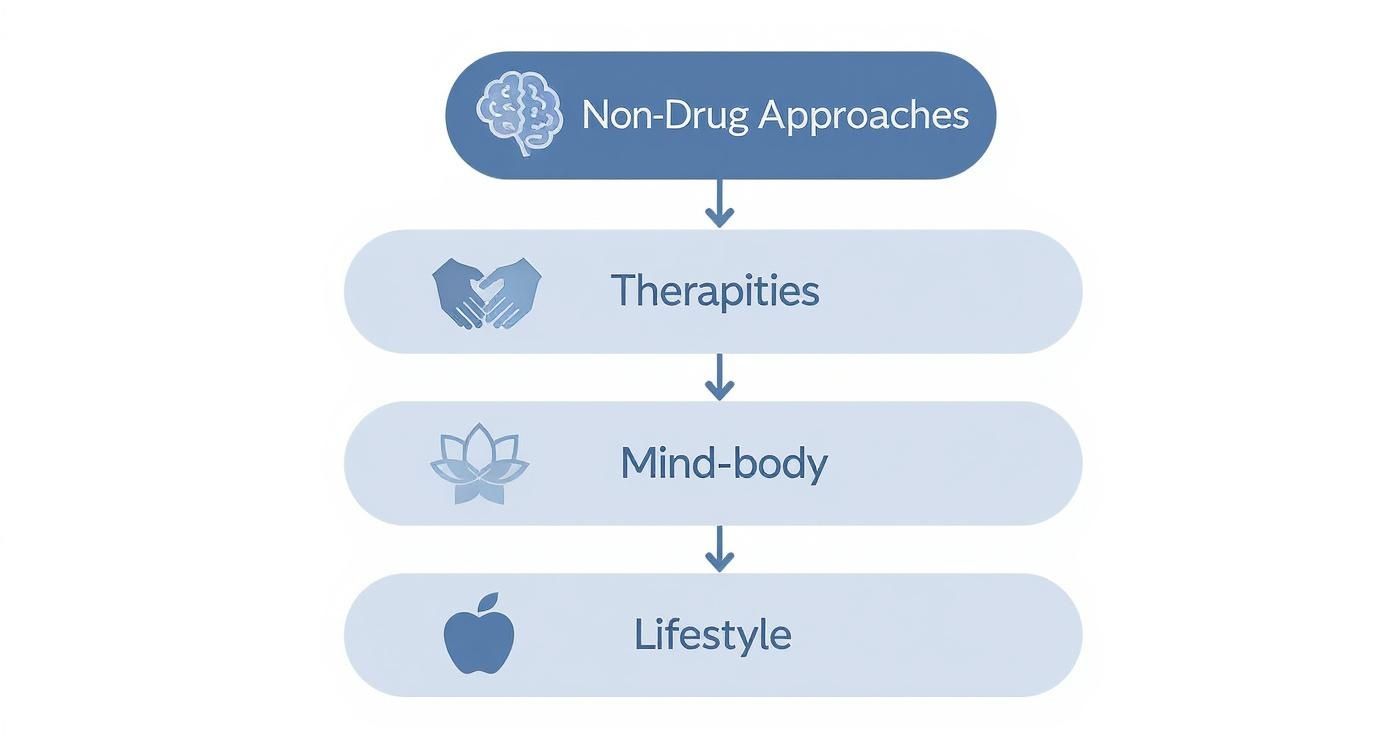
As you can see, a truly effective pain relief plan often pulls from several of these categories, creating a strategy that’s as unique as you are.
To better understand these approaches, let's look at the foundational concepts behind them. This table summarizes the main therapy types, what they aim to do, and a few common examples of each.
Core Pillars of Non-Drug Pain Therapies
| Therapy Pillar | Core Principle | Common Examples |
|---|---|---|
| Physical and Manual | Retraining the body's mechanics and correcting structural imbalances. | Physical Therapy, Chiropractic Care, Massage Therapy, Tuina |
| Mind-Body | Rewiring the brain's pain signals and changing the perception of pain. | Meditation, Yoga, Biofeedback, Cognitive Behavioral Therapy (CBT) |
| Traditional and Energy-Based | Restoring the body's natural balance and stimulating self-healing. | Acupuncture, Herbal Therapy, Reiki, Qigong |
Each of these pillars offers a distinct yet complementary path toward relief. Now, let’s explore what makes each one so effective.
H3: Physical and Manual Therapies
At their core, physical and manual therapies are all about retraining the body’s mechanics. Think about it—pain often pops up when something is physically out of whack. A weak muscle, a stiff joint, or even just poor posture can put a huge strain on your body, leading to chronic discomfort. These therapies get to the root of those physical problems.
Physical therapy is a perfect example. A great physical therapist is like a biomechanical detective; they analyze how you move to figure out why you're hurting. They don't just treat the symptom. Instead, they prescribe targeted exercises and stretches to strengthen weak spots, improve your flexibility, and get your body moving correctly again, fixing the problem at its source.
Other key manual therapies include:
- Chiropractic Care: Focuses on properly aligning the spine to take pressure off nerves and improve how your whole body functions.
- Massage Therapy: Aims to release tight muscles, break down scar tissue, and boost circulation to sore, inflamed areas.
- Tuina (Chinese Medical Massage): Uses rhythmic compression along specific energy pathways to relax muscles and jump-start the body's healing response.
H3: Mind-Body Techniques
The next pillar focuses on rewiring the brain’s pain signals. This is a crucial piece of the puzzle because pain is more than just a physical sensation—it’s an experience your brain interprets. With chronic pain, the brain can get stuck in a feedback loop, becoming so sensitive that it keeps sending out strong pain signals even after an injury has healed.
Mind-body practices are designed to break that cycle. They work by teaching you how to calm your nervous system and fundamentally change how your brain perceives pain. Mindfulness meditation, for instance, trains you to observe painful sensations without that immediate, panicked reaction. This simple shift in perspective can dramatically lower the pain's intensity and ease the emotional weight that comes with it.
By focusing on the connection between your mental state and physical sensations, you can gain a powerful sense of control. This approach empowers you to actively manage your pain from the inside out, rather than feeling like a passive victim of your symptoms.
Other powerful mind-body tools include cognitive behavioral therapy (CBT), yoga, and biofeedback. Our guide covering methods for natural chronic pain relief dives deeper into these and other techniques that put you back in the driver's seat.
H3: Traditional and Energy-Based Modalities
Finally, we have traditional modalities aimed at restoring the body’s natural balance. Practices like acupuncture and herbal medicine are built on a simple but powerful idea: your body has an incredible capacity to heal itself. Pain often arises when that natural equilibrium is thrown off by an injury, stress, or illness.
These therapies don't force change; they gently guide your body back to its optimal state. Take acupuncture, for example. It uses incredibly fine needles at specific points to stimulate nerve pathways, trigger the release of your body's own painkillers (like endorphins), and calm inflammation. The goal isn't just to block pain but to encourage your body to do what it does best—heal. This holistic view ensures the treatment addresses the whole person, not just a single symptom.
How Acupuncture and Herbal Therapies Work
When people hear about traditional practices like acupuncture and herbal medicine, they sometimes imagine something mystical. But the truth is, these are sophisticated, science-based methods for managing pain without drugs. They work by tapping into your body's own incredible ability to heal itself. Instead of just putting a band-aid on the pain, they aim to correct the underlying imbalance that's causing it in the first place.
Let's pull back the curtain and see exactly how these ancient techniques deliver very real, modern results.
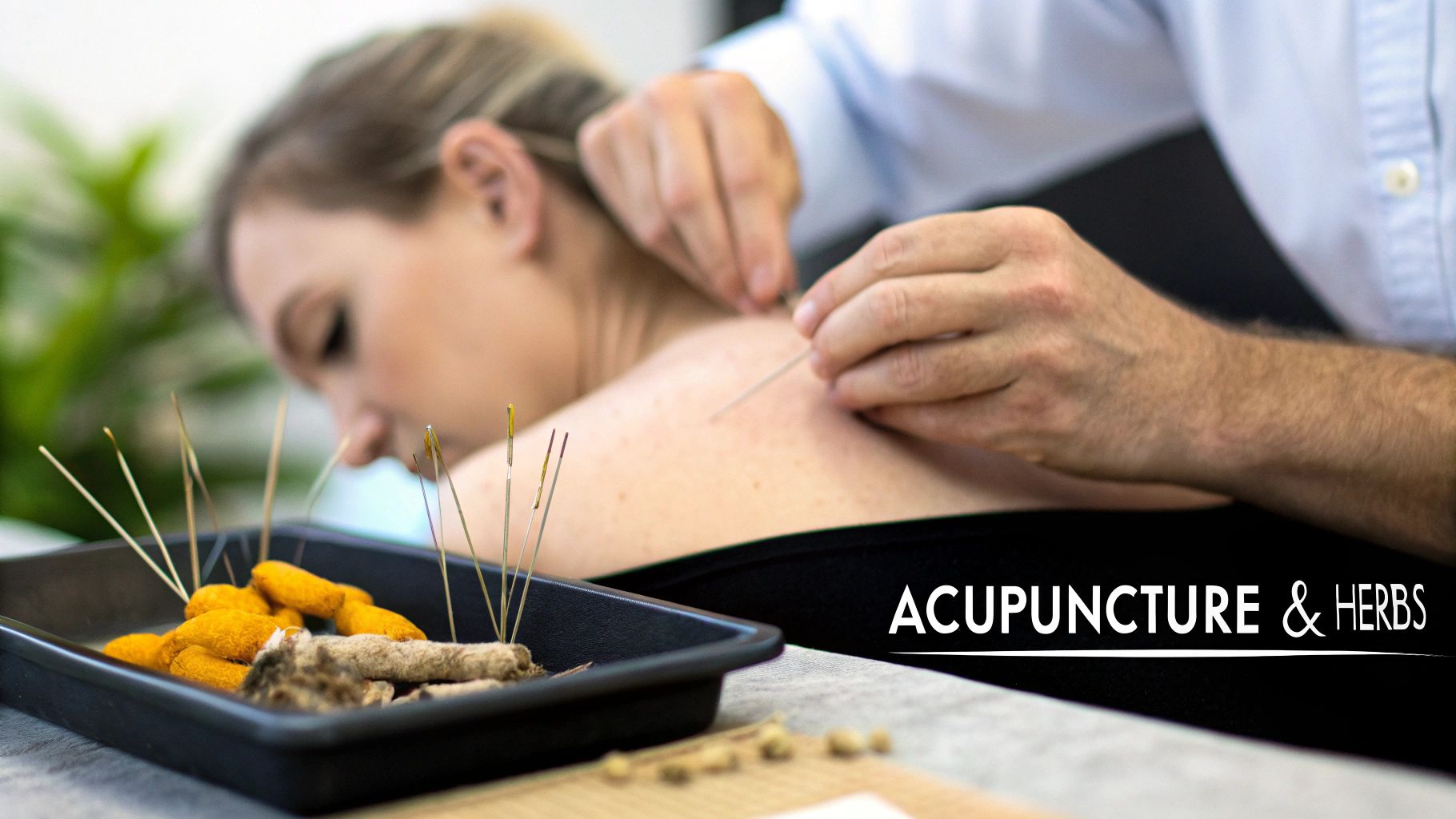
Acupuncture: Restoring Your Body's Communication System
At its heart, acupuncture is a very precise way of communicating with your nervous system.
Picture your body's nerve network as a complex electrical grid. Pain, injury, or even chronic stress can act like a short circuit or a frayed wire, disrupting the signals that are supposed to flow smoothly. This is where an acupuncturist comes in—they’re like a skilled electrician for your body.
By inserting incredibly thin, sterile needles into specific locations called acupoints, they stimulate nerves, muscles, and the surrounding connective tissue. This sends a clear, new message straight to your brain, essentially telling it to reboot the faulty circuit.
This simple action kicks off a cascade of powerful physiological responses that all work together to relieve pain.
- Releasing Natural Painkillers: The stimulation triggers your brain to release endorphins and enkephalins. These are your body's built-in pain-relieving chemicals—the same ones responsible for a "runner's high."
- Calming Inflammation: Acupuncture helps dial down the inflammatory response right where it hurts. It boosts circulation, bringing fresh, oxygenated blood to the area to flush out inflammatory byproducts and speed up tissue repair.
- Modulating Pain Signals: The therapy can effectively interrupt or alter the pain messages traveling from the injured area to the brain. It’s like turning down the volume on your discomfort.
The real goal of acupuncture isn’t just temporary relief; it's about restoring proper function. By correcting those underlying signaling problems, it empowers your body to manage pain more effectively on its own, leading to results that last.
Herbal Therapy: Nature's Pharmacy for Targeted Relief
Herbal therapy follows the same core principle of restoring balance, but it gets there by using the biochemical power of plants. This is far more nuanced than just grabbing a supplement off the shelf. Think of it as a form of natural pharmacology, where specific plant compounds are expertly combined to target your unique condition.
It’s like using a gentler, smarter version of pharmaceuticals. Instead of one single, high-impact synthetic chemical, an herbal formula contains a thoughtful blend of compounds that work together synergistically. This multi-pronged approach often means fewer side effects while still addressing the complex, interconnected nature of chronic pain.
For instance, a skilled practitioner might design a custom formula that includes:
- Turmeric (Curcuma longa): Prized for its powerful anti-inflammatory compound, curcumin, which is a go-to for reducing the swelling and pain seen in conditions like arthritis.
- Ginger (Zingiber officinale): Frequently used to relax tense muscles, soothe nausea, and improve blood flow to sore, tight areas.
- Corydalis (Corydalis yanhusuo): A well-known herb in traditional medicine for its analgesic properties, making it particularly effective for nerve pain and muscle spasms.
The Importance of a Qualified Practitioner
Both acupuncture and herbal therapy are incredibly powerful tools, but their success hinges entirely on the skill and knowledge of the person administering them.
A licensed acupuncturist and herbalist has gone through years of rigorous training to understand the body's intricate systems and how to apply these therapies safely and correctly. They don't just treat a symptom. They perform a thorough diagnosis to get the full picture of your health.
This diagnostic process is what makes the treatment truly personal and effective. Your practitioner will consider your health history, your lifestyle, and the unique patterns of your pain to choose the exact right acupoints or craft the perfect herbal blend for you. This customized, whole-person approach is a cornerstone of what is Traditional Chinese Medicine and is absolutely key to getting the best possible results on your journey to a life with less pain.
Mastering Physical and Mind-Body Therapies
Beyond treatments like acupuncture, some of the most powerful non-drug pain management tools empower you to take a direct, hands-on role in your own recovery. These methods generally fall into two camps: physical therapies that get your body’s mechanics right, and mind-body techniques that actually reshape how your brain processes pain. When you learn to master both, you build a truly formidable defense against discomfort.
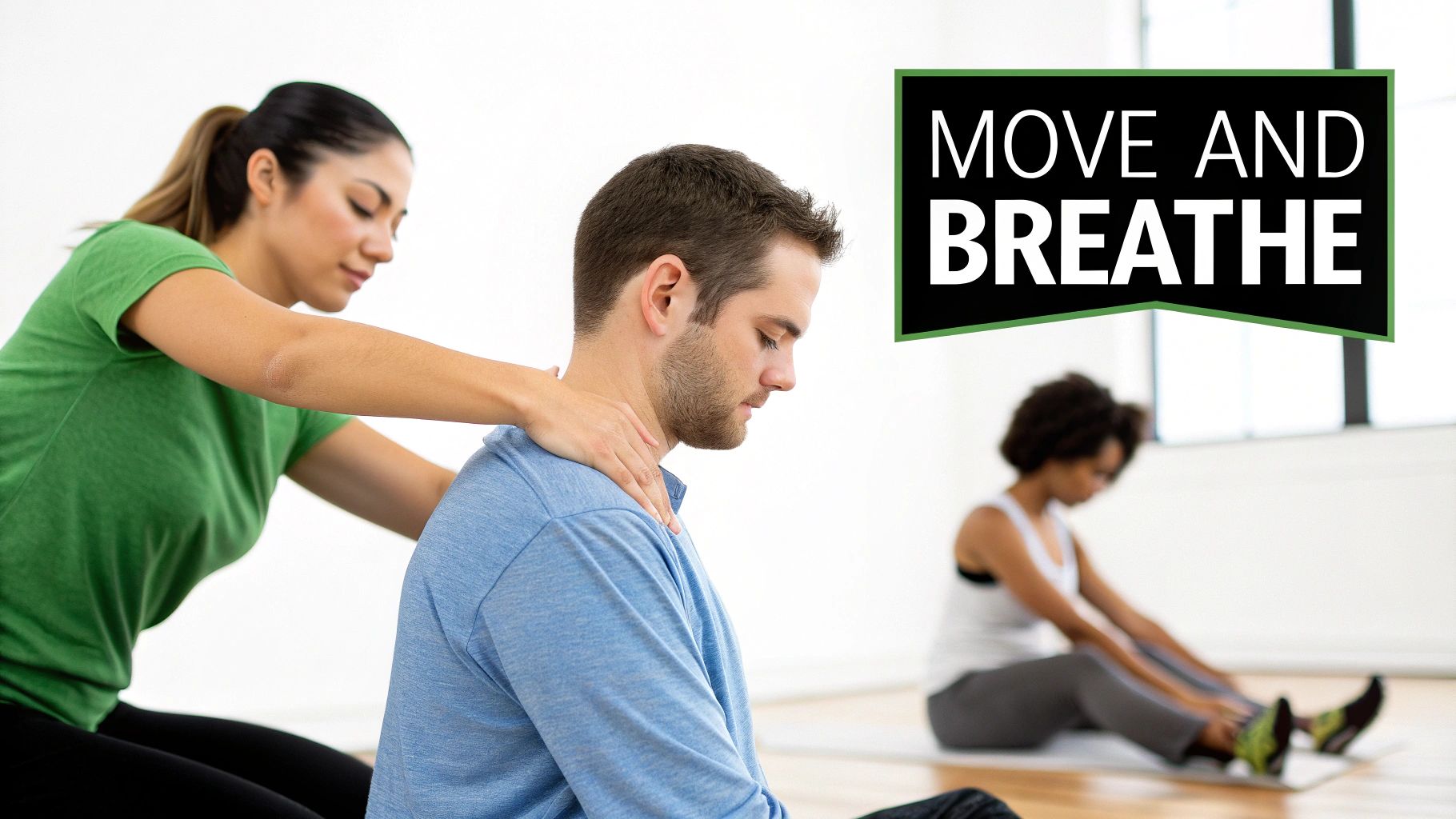
It’s this active participation that really sets these therapies apart. Instead of just receiving treatment, you become the driving force behind your own healing, learning new skills and movements that bring lasting relief.
Correcting the Root Cause with Physical Therapy
Physical therapy isn't just a list of exercises to check off. It’s a personalized roadmap designed to fix the underlying mechanical problems that are causing your pain in the first place.
Think of a great physical therapist as a skilled mechanic for your body. They don’t just muffle the rattling noise; they find the loose bolt causing it and tighten it. By pinpointing and correcting these biomechanical imbalances, a therapist helps restore your strength, flexibility, and proper movement patterns. This targeted approach means you're not just putting a band-aid on the symptoms—you’re actively solving the problem at its source.
A solid program usually includes a mix of:
- Targeted Strengthening: Building up the weak muscles that aren't supporting your joints correctly.
- Flexibility and Mobility Work: Gently lengthening tight muscles and improving your range of motion to take the strain off.
- Postural Correction: Retraining your body to sit, stand, and move in ways that won't create pain down the road.
The move toward these non-drug strategies is becoming a major trend in healthcare. In North America, for instance, high healthcare spending and advanced pain protocols have led the region to account for between 39.4% and 48.3% of the global non-opioid pain treatment market. You can explore more on the global non-opioid market and its growth at coherentmarketinsights.com.
Physical therapy gives you a blueprint for how to move. It teaches you how your body is meant to function, empowering you with the knowledge and strength to keep pain from coming back long after your sessions are over.
Rewiring Your Brain with Mind-Body Practices
Pain isn't just a physical sensation—it's an experience that your brain interprets and processes. With chronic pain, it's easy to get caught in a vicious cycle: the pain causes stress, and that stress makes the pain feel even worse. Mind-body therapies are designed to break that destructive loop.
These techniques work by calming your nervous system and changing your brain's relationship with pain signals. You learn how to manage your reaction to discomfort, which can dramatically lower how intense the pain actually feels.
Key Mind-Body Techniques for Pain Relief
-
Mindfulness Meditation: This practice is all about focusing on your breath and simply observing your thoughts and sensations without judging them. It trains you to step back from the knee-jerk reaction to pain and stress, giving you a powerful sense of control.
-
Biofeedback: Here, you use electronic sensors to get real-time feedback on things like your heart rate or muscle tension. By seeing these metrics on a screen, you can learn to consciously control them, effectively teaching yourself to relax tense muscles and quiet your body's stress response on command.
-
Cognitive Behavioral Therapy (CBT): Often seen as a gold standard in pain psychology, CBT helps you identify and reframe the negative thought patterns that can amplify pain. When you change how you think about pain, you can change your emotional and physical response to it.
The connection between your mental state and physical well-being is incredibly strong. By learning to calm your mind, you can also calm your body, which is a game-changer for conditions where stress is a major trigger. For anyone caught in this cycle, it’s worth taking the time to learn how to reduce anxiety naturally as part of a complete pain management plan. These skills are like a portable toolkit you can use anytime, anywhere, to take back control.
Using Technology for Modern Pain Management
Technology is opening up some fascinating new doors for managing pain without drugs, combining age-old healing ideas with powerful tools you can use yourself. These advancements are making it easier than ever to get a handle on pain without relying on systemic medication, offering targeted solutions that work with your body, not against it.
From clever devices that actually interrupt pain signals to smart systems that can fine-tune your treatment plan, technology is changing the game.
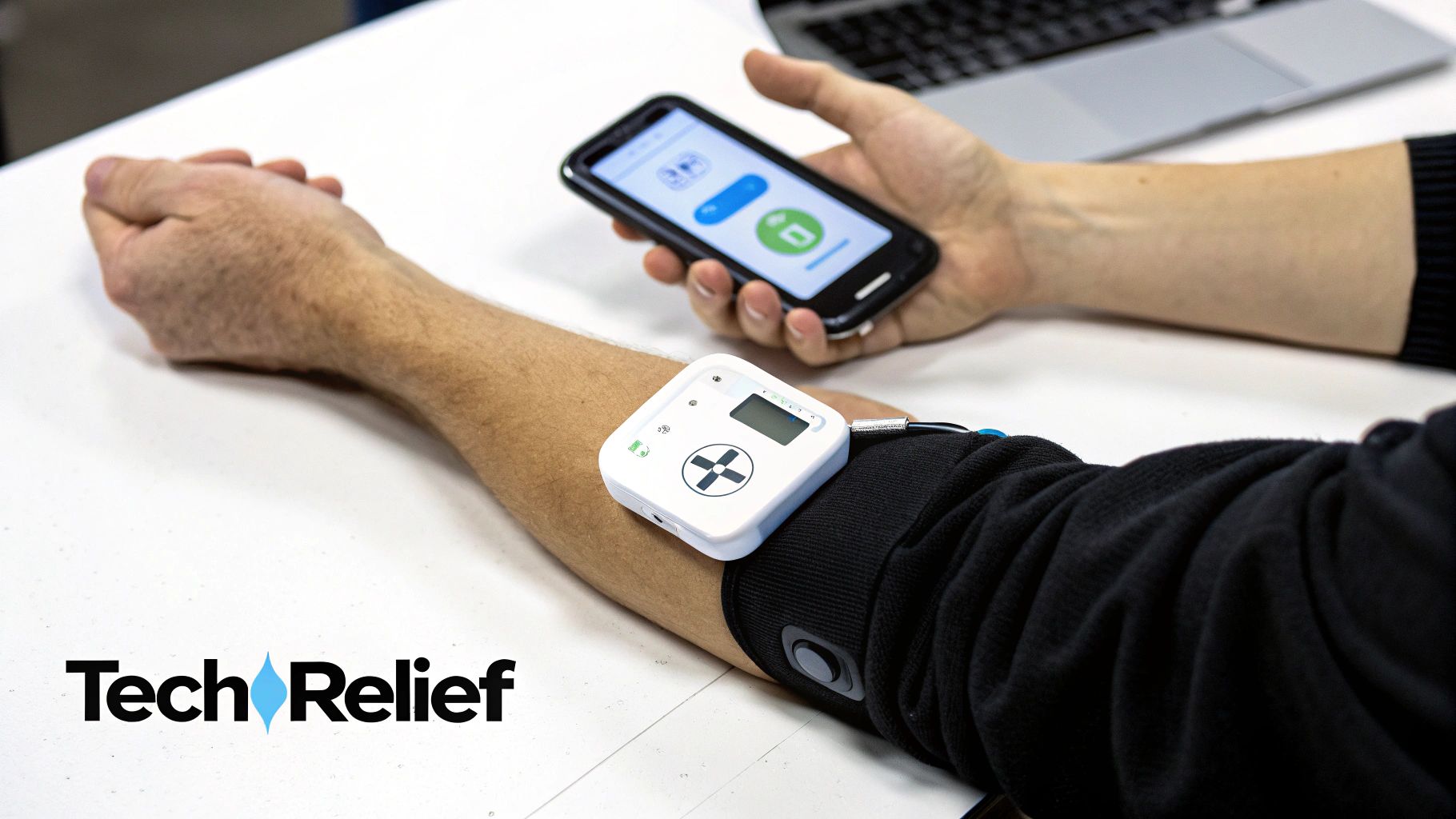
Interrupting Pain Signals With TENS Units
One of the most common and accessible gadgets is the Transcutaneous Electrical Nerve Stimulation (TENS) unit. These are small, portable devices that give you a straightforward way to deal with localized pain.
So, how do they work? Imagine your nerves are like telephone lines sending pain messages straight to your brain. A TENS unit sends gentle electrical pulses through sticky pads you place on your skin. These pulses are like "static on the line," scrambling the pain signal so it never makes it to the brain. This is often explained by the "gate control theory of pain," where the mild electrical sensation essentially closes a neurological "gate," stopping the pain messages from passing through.
It’s a simple concept, but it provides real, temporary relief for all sorts of issues, including:
- Muscle soreness and stiffness
- Joint pain from arthritis
- Low back pain and sciatica
Delivering Relief With Non-Opioid Patches
Another brilliant innovation is the non-opioid pain patch. These patches deliver active ingredients, like lidocaine or capsaicin, directly through your skin right to the source of the pain. This is a huge leap forward from oral medications because it concentrates relief exactly where it’s needed, helping you sidestep the side effects that often come with drugs that have to travel through your entire system.
This targeted approach has made non-opioid patches one of the fastest-growing areas in pain management. The global market for these patches was valued at around USD 991.6 million and is expected to nearly double to USD 1.8 billion by 2034. This trend signals a major shift toward localized, non-systemic pain relief. You can discover more about this market's expansion and trends on precedenceresearch.com.
By bypassing the digestive system and delivering relief right at the source, these technologies offer a more direct and often safer method for managing localized chronic pain, minimizing systemic impact while maximizing effectiveness.
The Future of Personalized Pain Care
Looking ahead, artificial intelligence (AI) is poised to take personalized pain management to a whole new level. AI algorithms can sift through massive amounts of data—your medical history, diagnostic scans, daily activity, and reported symptoms—to see the bigger picture.
By catching subtle patterns a person might miss, AI can help your practitioner:
- Pinpoint the most effective mix of therapies for your specific needs.
- Adjust your treatment plan in real-time based on how you're responding.
- Predict potential pain flare-ups before they even start, allowing you to be proactive.
This data-driven approach is paving the way for a future where your pain management plan isn't just based on general guidelines, but is meticulously fine-tuned to your unique body and life. It's the ultimate combination of ancient healing wisdom and modern analytical power, charting a clearer, more effective path toward lasting relief.
Building Your Personalized Pain Relief Plan
Knowing your options is a great start, but real change happens when you put that knowledge into practice. Crafting an effective non drug pain management strategy isn't about chasing a single magic bullet. It’s about creating a personal, integrated plan where different therapies work in harmony to bring you lasting relief.
Think of this as your roadmap to a life with less pain, built on a solid foundation of professional guidance, clear goals, and your own consistent effort.
Start with Professional Consultation
Before jumping into any new treatment, your first and most critical move is to talk with qualified healthcare professionals. Your primary care physician is the perfect person to see first. They can rule out any serious underlying issues and then connect you with specialists who live and breathe non-drug therapies.
Your core team might end up including:
- A physical therapist who can analyze how you move and design an exercise program just for you.
- A licensed acupuncturist to tackle pain and inflammation from a traditional medicine viewpoint.
- A therapist specializing in chronic pain, perhaps someone trained in Cognitive Behavioral Therapy (CBT).
This kind of team-based approach makes sure your plan is safe, coordinated, and truly fits your unique situation. When you work with experts, you take the guesswork out of the equation and start on the right foot from day one.
Define Your Goals and Track Progress
With your team assembled, it's time to set clear, realistic goals. What does "less pain" actually mean for you? Instead of a vague wish to "feel better," get specific.
For instance, your goals could be:
- Reduce morning stiffness so you can walk the dog for 15 minutes without stopping.
- Cut back on over-the-counter pain relievers by 50% within three months.
- Sleep better by getting six straight hours of rest each night.
To know if the plan is working, you have to track your progress. A simple journal—whether it's on paper or an app—is an incredibly powerful tool. Jot down your pain levels on a 1-10 scale, what you did that day, which therapies you used, and how you felt. This data is pure gold for you and your team, showing what’s helping and what needs a tweak.
A well-structured plan is a living document. It should adapt as your symptoms change and you discover which combination of therapies gives you the most relief. This flexibility is key to long-term success.
Integrate and Adjust Your Approach
The real magic of non-drug pain management happens when you combine therapies. Research shows time and again that a multi-pronged approach is far more effective than relying on just one thing. For example, physical therapy can help fix a mechanical issue in your lower back, while acupuncture works to calm the inflammation and quiet the pain signals that go with it.
Your weekly schedule might blend different modalities, like physical therapy on Mondays and Wednesdays, a yoga class on Friday, and a few minutes of mindfulness meditation every day. Keep the lines of communication with your care team open. Share your wins and your struggles so they can help you fine-tune the strategy. As you build your plan, it can be helpful to see what this looks like in practice; explore these practical treatment plan examples to see how different elements can be woven together.
In the end, this process is about empowerment. It puts you back in the driver’s seat of your own health, shifting you from someone who just receives care to an active partner in your own healing.
Common Questions About Managing Pain Without Drugs
It’s only natural to have a few practical questions when you’re thinking about trying a new approach to pain relief. Figuring out the logistics—how long it takes, what it costs, and how it all works together—is a huge part of feeling comfortable and ready to start. Let's walk through some of the most common questions people have when they first explore these therapies.
Getting these details sorted out from the beginning helps you know what to expect and lets you build a plan that actually fits into your life.
How Long Until I Start Feeling Better?
This is usually the first thing people ask. Unlike popping a pill for quick, temporary relief, these treatments are about creating real, lasting change in your body. That means the timeline isn't one-size-fits-all.
If you're dealing with something new, like a recent muscle strain, you could feel a real difference after just one or two sessions of acupuncture or physical therapy. But for chronic pain that you've been living with for years, it's more of a gradual process. Think of it like turning a big ship—it takes consistent effort to change its course. To see significant, long-term improvement, a typical treatment plan might involve 6-12 sessions.
The most important thing to remember is that consistency trumps speed. Each session builds on the one before it, slowly teaching your body how to manage pain differently and encouraging deeper healing.
Can I Use Different Therapies at the Same Time?
Yes, you absolutely can. In fact, that's often the best way to get results. When you combine different types of treatment, you're tackling the pain from multiple angles, which can create a much more powerful effect. This is the whole idea behind integrative medicine.
A really solid plan might include a mix like this:
- Physical Therapy: To fix the root mechanical issues and build strength where you need it.
- Acupuncture: To calm inflammation, trigger your body's own painkillers, and regulate nerve signals.
- Mindfulness Meditation: To help you handle the stress and anxiety that almost always come with chronic pain.
The key is making sure your chosen therapies work well together. Keep all of your providers in the loop so everyone is on the same page, working toward the same goal in a coordinated, safe way.
Will My Insurance Cover This?
This is a big one for almost everyone. The good news is that insurance companies are getting much better about covering non-drug pain treatments as their effectiveness becomes more widely recognized.
What’s covered really comes down to your specific insurance provider and plan. Many plans now include benefits for physical therapy, chiropractic care, and even acupuncture, particularly for well-documented issues like chronic low back pain or migraines. The American College of Physicians now recommends starting with non-drug options for low back pain, which has definitely helped push insurers in the right direction.
Before you start any treatment, your best bet is to call your insurance company directly. Ask them to verify your benefits for the specific therapies you're considering and check if you'll need a referral from your primary doctor to get coverage.
What’s the Best Way to Treat Nerve Pain?
Nerve pain, also known as neuropathy, is a different beast because it comes directly from the nervous system. It needs a careful, multi-faceted approach.
For this kind of pain, an integrated strategy usually works best. Acupuncture, for example, has been shown to be very effective for calming overactive nerve signals and modulating the pain pathways. At the same time, physical therapy can help by using targeted exercises and hands-on techniques to decompress any pinched or trapped nerves. Adding mind-body practices can also make a huge difference by helping to change how your brain perceives those nerve sensations, essentially turning down the "volume" on the pain.
At Eric Tsai Acupuncture and Herbs, we specialize in creating personalized, integrated treatment plans that get to the root of your pain. Dr. Tsai combines deep knowledge of Traditional Chinese Medicine with a background in Western pharmacy to offer you a balanced, effective path to relief. We accept most major insurance plans and are ready to help you build a strategy for long-term wellness. Start your journey to a life with less pain by scheduling a consultation today.

